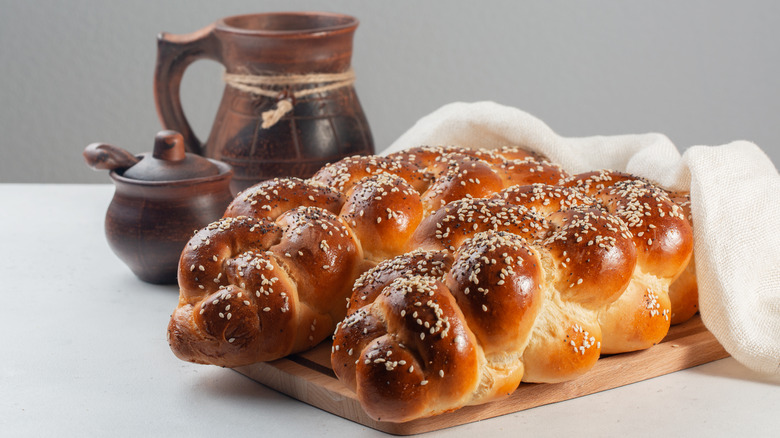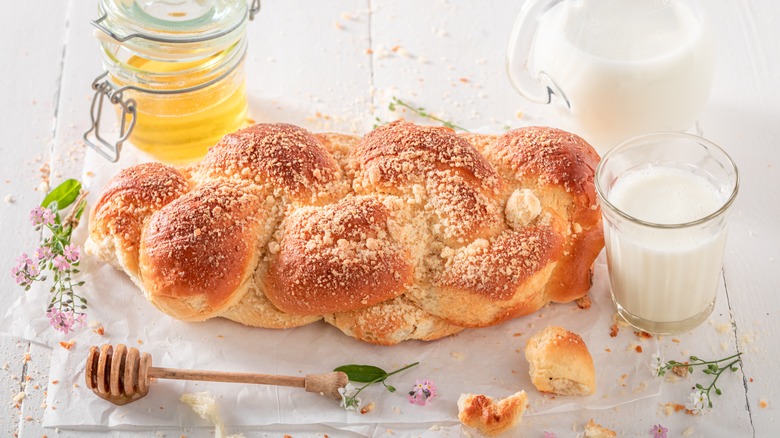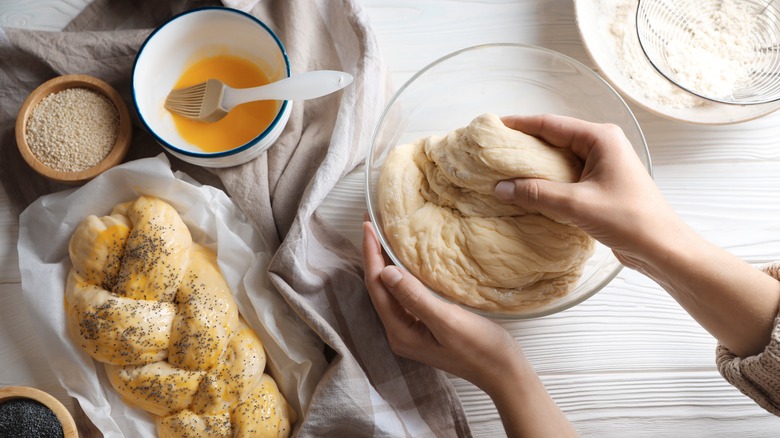What To Look For When Buying Challah Bread
Challah bread perfectly encapsulates the magic of age-old traditional recipes. It originates from Ashkenazi Jewish culture — where it is served as a centerpiece at Friday night Shabbat dinners to be shared among friends and family. The intricate preparation and braiding of the dough gives challah its iconic tortoiseshell appearance and makes it especially memorable.
You can pick the perfect challah from your local bakery by looking for a few key signs. The challah's crust should be shiny and buttery in appearance. A taut crust indicates a fresh loaf that hasn't lost its crispness from overexposure to air and moisture.
The color of the crust is important too: Pick a challah with a warm medium-dark brown color on each knot. Darker than this, and your challah may be charred, and lighter means you'll miss out on that delicious contrast between soft, fluffy inside, and crisp, crunchy outside.
When you pick it up and tap the bottom, it should make a hollow sound. This means the dough has risen well and that there is air in the loaf, making for a soft, pillowy texture.
How to serve challah bread
Challah is known today for its sweetness, thanks to plenty of added sugar — but originally, when challah — as we know it today — was first eaten in Germany, it lacked the sugar that's popular now. It can also be treated as savory because it's enriched, which means that fats, like eggs and oil, are added. With this sweet and savory combo, challah makes for a highly versatile delicacy — you can even make a sticky, pull-apart cinnamon challah braid for your next big brunch.
Traditionally, challah is served sliced and sprinkled with kosher salt or is torn apart and dipped in honey. It's normally served to accompany a meal and is traditionally eaten by tearing off a piece with your hand.
Challah also pairs perfectly with the ingredients of classic dishes like French toast with syrup or sweet fruits. Challah is an excellent choice for this dish because of its higher fat content, which complements the sweetness of the toppings. It's also highly porous and absorbent, soaking in the egg mixture beautifully before frying.
You can use challah in non-traditional savory recipes, like onion challah rolls. It is also a great choice of bread for elevating the humble grilled cheese sandwich, as the subtle sweetness of challah provides an ideal balance to the salty cheese.
Bake flawless challah bread with these pro tips
Baking your own challah bread is worth the effort, especially if you'd like to experiment with different toppings and fillings, and test out savory or sweet versions. The recipe for this baked treat is simple enough, involving a combination of flour, water, sugar, yeast, eggs, kosher salt, and sometimes sesame or poppy seeds as a topping.
Although the recipe is simple, baking the perfect challah can be tricky, especially when it comes to proofing — which you do twice, before and after braiding. You know you're finished proofing when the challah looks big and fluffy with a wrinkled surface. It needs to be about three times its original size after braiding.
When you're braiding your challah, don't pull the lengths of dough too tightly, as it needs room to rise when proofing. Thereafter, make sure you don't over-proof your dough after plaiting. If it proofs for too long, air bubbles in the dough get too big, causing them to pop and then deflate in the oven.



